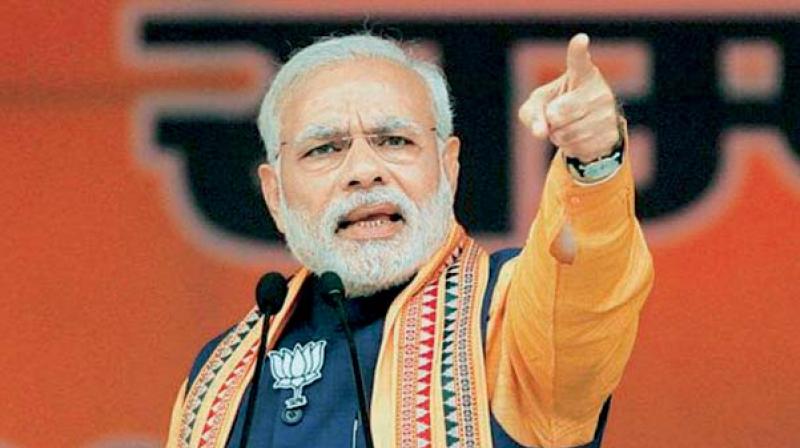Why Modi’s chowkidar campaign a non-starter
Prime Minister Modi was packaged as a doer, making decisions and implementing them at an unprecedented pace.
If Prime Minister Narendra Modi is really winning, then why does he look like a loser? The inverted snobbery of claiming that he was nothing but a humble a watchman of the nation has now come back to haunt him. His usual genius in political marketing is not evident in his 2019 campaign for re-election, which seems unsure, and even confused.
Prime Minister Modi’s attempt to turn around the Congress accusation “Chowkidar chor hai” (the watchman himself is the thief) by calling himself the First Chowkidar of the nation simply isn’t pressing the right buttons. Neither is his social media campaign calling upon citizens to sign up as watchmen #MeinBhiChowkidar (I am also a watchman).
That he should have allowed this to happen is particularly curious since the 2019 general election is centred around him. The 2014 election was led by a wave of anti-Congressism across the length and breadth of the country. The Congress lost even in those states where it was not even pitted against the BJP, and the result was evident in the meagre number of Lok Sabha seats it won — 44, the lowest in its history.
In this general election, by contrast, the persona of Prime Minister Modi is the sole reference point for the voter. The electoral choices are clearly polarised by pro-Modi and anti-Modi sentiments. In the face of anti-incumbency against his government, Mr Modi needs a positive vote in his favour. He needs to ignite his campaign, enthuse volunteers and swing the undecided voters.
On all these counts, his “chowkidar” campaign seems to be a failure. The sum and substance of Prime Minister Modi’s address to 25 lakh chowkidars earlier this week was still milking the sentiment of anti-Congress incumbency from five years’ ago. Only the right-wing Hindutva organisations have such a long and deep-seated hatred for the Congress version of nationalism. Normal citizens tend to have shorter memories and more immediate concerns.
Chowkidars are in fact a palpable reminder of public insecurity. A proliferation of citizen-chowkidars would underline the idea that the State is unable to protect its citizens. On top of that, security guards work in the most exploitative conditions. No one would actually aspire to their jobs, unlike, say, the glamour of being in the armed forces or snapping up a permanent government job.
The chowkidar campaign has also pushed into the background the chest-thumping nationalist narrative centred on Prime Minister Modi’s bombing of Pakistani territory. It had the potential to kickstart his campaign and rouse his supporters. Has he concluded, however, that the war narrative is not working or is he floundering?
His re-election campaign has been flitting from one slogan to another. On January 20, he introduced a potential tagline for his campaign, quoting a dialogue from the Bollywood film Uri: The Surgical Strike, asking an audience of film celebrities in Mumbai: “How’s the josh (enthusiasm)?” His supporters replied: “Josh is very high Sir”! “How’s the Josh” was sought to be revived after the Indian Air Force dropped bombs in Balakot in Pakistan, and it trended for a while on the social media.
However, by the end of February, “How’s the Josh” was replaced by the slogan: “Namumkin Ab Mumkin Hai (The impossible is now possible). Using data showcasing the government’s welfare schemes, full-page advertisements appeared in all the major newspapers. On March 14, finance minister Arun Jaitley’s blog revealed that the tagline had been amended to “Modi Hai To Mumkin Hai (Because Modi makes it possible)”. Prime Minister Modi was packaged as a doer, making decisions and implementing them at an unprecedented pace.
But the Prime Minister’s detractors quickly unravelled this catchy campaign with counter-slogans: “Chowkidar ka chori karna namumkin tha #NamumkinAbMumkinHai”, “Chowkidar hi chor hai kyonki #NamumkinAbMumkinHai”. The social media was trending with bon mots such as that it was impossible to mislead the Supreme Court, but Prime Minister Modi had made it possible; and that it was impossible to loot `30,000 crores (the offset offered to Anil Ambani’s companies by Dassault in the Rafale deal) from citizens, but it had been made possible; it was impossible for Jay Shah (BJP president Amit Shah’s son) to increase his turnover 16,000 times, but that too had been made possible; it was impossible to take unemployment rate to a 45-year high but Mr Modi had made it possible; and to top it all “entire political science mein degree nammumkin thi par #NamumkinAbMumkinHai” in a direct dig at the controversy about the Prime Minister’s claim of having got a master’s degree in “Entire Political Science”.
Perhaps the BJP was at its wit’s end when its strategists suggested that the party take on the Congress’ allegations frontally.
However, the “everyone-is-a-chowkidar” campaign is not really uplifting for the voters. Whereas his “chai par charcha (discussion over tea)” campaign during the 2014 general election had projected the voter as having a role in framing the nation’s future, the chowkidar campaign lacks the same buzz.
Only aspirational campaigns have worked well the world over historically. In the United States, the taglines that have won elections included “Vote Yourself a Farm” (Abraham Lincoln, 1860), “A chicken in every pot and a car in every garage”(Herbert Hoover, 1928), “Happy days are here again” (Franklin Delano Roosevelt, 1932), “Change we can believe in” and “Yes we can” (Barak Obama, 2008 and 2012) and “Make America great again” (Donald Trump, 2016).
In India, aspirational slogans have worked very well in the past, such as “Jai Jawan Jai Kisan” (Lal Bahadur Shastri, 1965 — although a mobilisational slogan, and not an election one), “Garibi Hatao” (Indira Gandhi, 1972), “Indira Hatao Desh Bachao” (Jaiprakash Narayan, 1977), “Congress ka haath, sabke saath” (Congress, 2004), and “Sabka saath sabka vikas” and “Achhe din aanewale hain” a la Roosevelt (Narendra Modi, 2014).
#MeinBhiChowkidar doesn’t fit into the aspirational slogans that have swung elections in the past. Far from setting the agenda, this is a defensive campaign that at best diverts attention from the Opposition’s corruption allegations. It is unlikely that as a chowkidar, Prime Minister Narendra Modi will be able to woo voters.



















